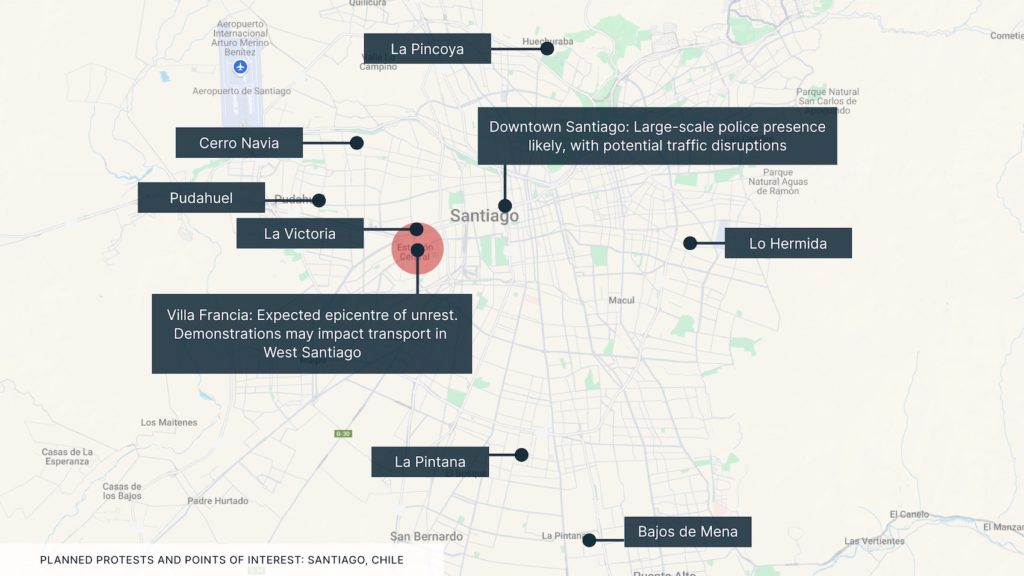Alert+
Disruptions Expected During March 29 Demonstrations in Chile
Intelligence cut off: 10:00 GMT 28 March 2025
On 29 March, Chile will observe the “Day of the Young Combatant” (Día del joven combatiente). The day commemorates the killing of the two Vergara Toledo brothers in Santiago in 1985 during the dictatorship of Augusto Pinochet. The two brothers were allegedly part of the Revolutionary Left Movement (MIR), a radical left-wing group that was at the forefront of the struggle against the dictatorship. The commemoration also extends to the other activists who were killed or imprisoned during the dictatorship. The anniversary has continued to be politically relevant, reflecting broader anti-government and anti-police sentiment.
There have been multiple notable instances of violence and vandalism during past anniversaries. In 2008, a series of bomb threats were sent to government offices and private businesses, including banks and media channels. In 2015, a police officer (Carabiniere) was shot and killed while carrying out an operation in La Victoria, Santiago. Even in years where similar incidents have not occurred, there are often reports of rioting and street violence, particularly at night after official commemoration events end. Activists frequently target businesses with improvised explosives and other weapons, as well as attacking police forces.
Due to its association with violent episodes and radical left-wing groups, the commemoration is politically controversial. Elements of the Chilean right have criticised the anniversary, with some publications calling it “Day of the Young Delinquent”.
Open-source intelligence (OSINT) investigations indicate that several protests are planned to occur in downtown Santiago on 29 March. A rally is scheduled for the Estacion Central area of Santiago starting at 15:30 local time. The area of Villa Francia in Estacion Central is a major focal point for protests, as it is the area where the two Vergara Toledo brothers were killed.

INTELLIGENCE ANALYSIS
High Likelihood of Violent Unrest During Day of the Young Combatant
There is a high likelihood of demonstrations coinciding with the commemorations. Unrest is likely to start in the late morning of 29 March and continue throughout the day, highly likely intensifying in the evening when organised rallies and protests conclude.
Santiago will almost certainly be the epicentre for protests and the city most impacted by traffic disruptions. The primary hotspot of unrest will almost certainly be Villa Francia in Estacion Central, where the 1985 killings occurred. Additionally, areas that will likely be affected include La Pincoya in Huechuraba, La Victoria in Pedro Aguirre Cerda, Lo Hermida in Penalolen, Bajos de Mena in Puente Alto, Pudahuel, La Pintana, and Cerro Navia.
Outside Santiago, unrest is possible in central districts of Valparaiso, Conception, Telmuco, and other Chilean cities. There is a realistic possibility that protests will be driven by other grievances disconnected from the commemoration. For instance, there are ongoing protests in Valparaiso over a controversial fishing sector law; local left-wing groups may seek to stage joint unrest during the Day of the Young Combatant to capitalise on visibility.
While protests during the morning and early afternoon will likely be peaceful, clashes with security forces are possible. Later in the day, particularly at night, the likelihood of violent unrest will increase considerably.
Past demonstrations during the Day of the Young Combatants have consisted of protesters erecting makeshift barriers, burning tyres, vandalising private businesses (particularly banks and the offices of foreign companies), firing projectiles including fireworks, and throwing Molotov cocktails at the police and other targets.
Some demonstrators will likely be armed and are likely to seek direct confrontation with police forces. Chilean police will almost certainly deploy violent crowd control measures in response to the unrest, including tear gas, pepper spray, water cannons, and possibly rubber bullets. Past demonstrations have resulted in dozens of arrests.
While protesters are unlikely to intentionally target bystanders, the nature of the unrest will likely increase the potential for incidental harm.
Travel Risk Advice: Safety Guidelines for Chile
- Avoid Estacion Central throughout 29 March.
- Closely monitor local news reports and government alerts.
- Monitor official public transport channels for updates on disruptions to mobility in Santiago and other affected cities.
- Plan for alternative routes and means of transport in Santiago and other large cities. Allocate more time for all transport.
- If caught in a protest area, try to leave quickly if it is safe to do so.
- If you are in a crowd and unable to leave, take precautions to minimise the risk of crowd crush. These include staying upright, moving away from all hard barriers, going with and not against the crowd, and holding your arms at chest level in a boxer-like stance to relieve pressure.
- Minimise all travel on foot.
- Avoid travelling after dark due to a greater risk of violence.
- Ensure that you always carry personal identification documents or copies.
- Have emergency contact numbers saved on your phone. These should include the local authorities, medical facilities, and any consular support.
- Ensure that mobile phones are charged.
- Monitor the Solace Secure platform and trusted local media.

